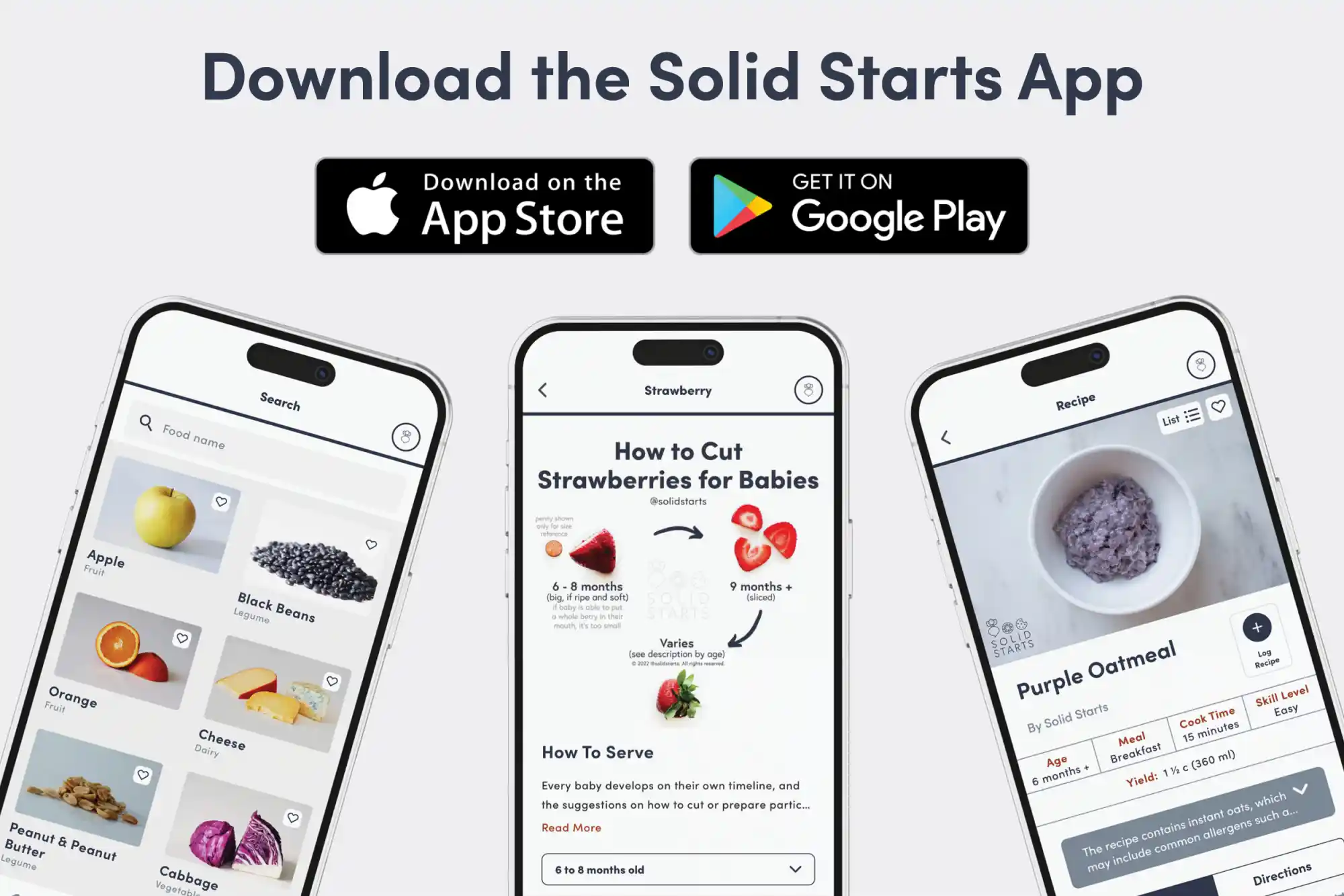Access our First Foods® Database in the Solid Starts App.
Learn moreSorghum
Grain
Age Suggestion
6 months
Iron-Rich
No
Common Allergen
No

When can babies have sorghum?
Sorghum may be introduced as soon as baby is ready to start solids, which is generally around 6 months old.
Native to central and south Africa, sorghum is a type of grass seed also known as great millet, milo, or jowar. Sorghum flour is a key ingredient in a fermented flatbread called injera and porridges such as tô and uji; cracked sorghum gets mixed with seasonal vegetables in jowar upma, an Indian breakfast; and popped sorghum (jowar dhani) is a popular Indian snack.
How do you serve sorghum to babies?
Every baby develops on their own timeline, and the suggestions on how to cut or prepare particular foods are generalizations for a broad audience.
6 months old +:
Make sorghum porridge and experiment with nutrient-rich cooking liquids like buttermilk, coconut milk, or vegetable stock. Combine with butter or ghee, and your preferred flavors and spices. To serve sorghum as finger food, mix the cooked grains with ground meat or mashed vegetables to make balls or fritters—shapes that are easier for baby to grab. Alternatively, serve strips of pancakes, waffles, age-appropriate baked goods, or pastas made with sorghum flour.
9 months old +:
Offer porridge, fritters, or meatballs made with cooked sorghum. When you see signs of the pincer grasp (where the thumb and index finger meet), feel free to share grain salads with baby. Flattening the grains with the back of a fork can help them stick together, which makes it easier for baby to self-feed. Alternatively, mix sorghum salads with a soft, scoopable food like mashed vegetables or yogurt. You can also serve sorghum flour pancakes or waffles in strips for practice taking bites or in bite-sized pieces to promote the pincer grasp.
12 months old +:
Offer cooked sorghum, either as finger food, as part of a grain salad, or mixed into other soft, scoopable foods. If the child struggles to pick up the grains on their own, flattening sorghum with the back of a fork can help them stick together and make them easier to pick up. Serve bread, pancakes, pasta, and other products made with sorghum flour. At this age, you can also serve popped sorghum on its own, if desired.
Videos
Is sorghum a choking hazard for babies?
No, but loose whole sorghum and popped or puffed sorghum could pose an aspiration risk (when something is breathed into the airway but doesn’t block it). To reduce the risk, prepare and serve sorghum in an age-appropriate way. As always, make sure you create a safe eating environment and stay within an arm’s reach of baby during meals. For more information on choking, visit our sections on gagging and choking and familiarize yourself with the list of common choking hazards.
Is sorghum a common allergen?
No, sorghum is not classified as a Global Priority Allergen by the World Health Organization. While allergies to pollen from a variety of sorghum grass (Sorghum halepense) have been reported, there is little information on allergies to the sorghum we eat (Sorghum bicolor).
As with introducing any new food, start by serving a small quantity for the first few servings, and if there is no adverse reaction, gradually increase the quantity over future meals.
Is sorghum healthy for babies?
Yes. Sorghum is rich in carbohydrates to provide quick energy and fiber to help baby’s gut microbiome flourish and balance blood sugar levels. It’s also rich in zinc, vitamin B6, magnesium, and selenium, as well as a dash of iron, important nutrients that baby needs for growth and development. Sorghum is full of antioxidants and polyphenols—plant nutrients that help improve the body’s resilience and recovery.
Is sorghum gluten-free?
Yes. Sorghum is gluten free, making it safe for those with wheat allergy, celiac disease, or non-celiac gluten sensitivity. Talk to a pediatric health care provider if you are concerned about issues related to gluten and digestion. See our celiac page for more information.
When can babies have popped sorghum?
Popped sorghum can be sprinkled on top of or mixed into other foods as soon as baby is ready for solids, generally around 6 months old so long as the food that it is mixed into is soft. Because of the potential for the tiny, dry, light-weight popped grains to be accidentally sucked into the airway if not mixed into other foods, we recommend avoiding serving them on their own and avoid serving it mixed into crunchy foods such as crackers or granola until after 12 months.
Are the anti-nutrients in sorghum safe for babies?
Yes. Often called anti-nutrients, these naturally-occurring plant compounds (including lectins, oxalates, and phytates) break down during the soaking and cooking process and are generally harmless in healthy people when consumed as part of a balanced diet. Some antinutrients can even offer health benefits, such as antioxidant and anti-cancer properties.
Our Team
Written by
- 1.
Zemmer, F., Cenk, E., Dahl, Å., Galan, C., & Ozkaragoz, F. (2021). A multidisciplinary approach of outdoor aeroallergen selection for skin prick testing in the geographical area of Greater Istanbul. European annals of allergy and clinical immunology, 10.23822/EurAnnACI.1764-1489.188. Advance online publication. DOI: 10.23822/EurAnnACI.1764-1489.188
- 2.
Petroski, W., Minich, D. M. (2020). Is There Such a Thing as "Anti-Nutrients"? A Narrative Review of Perceived Problematic Plant Compounds. Nutrients, 12(10), 2929. DOI:10.3390/nu12102929. Retrieved May 24, 2021.
- 3.
Singh, B., Singh, J. P., Shevkani, K., Singh, N., & Kaur, A. (2017). Bioactive constituents in pulses and their health benefits. Journal of food science and technology, 54(4), 858–870. DOI: 10.1007/s13197-016-2391-9. Retrieved September 16, 2022
- 4.
Deol, J. K., Bains, K. (2010). Effect of household cooking methods on nutritional and anti nutritional factors in green cowpea (Vigna unguiculata) pods. Journal of food science and technology, 47(5), 579–581. DOI:10.1007/s13197-010-0112-3. Retrieved September 19, 2022
- 5.
Chitra, U., Singh, U., Rao, P.V. (1996). Phytic acid, in vitro protein digestibility, dietary fiber, and minerals of pulses as influenced by processing methods. Plant foods for human nutrition (Dordrecht, Netherlands), 49(4), 307–316. DOI:10.1007/BF01091980. Retrieved August 4, 2022
- 6.
Grases, F., Costa-Bauza, A., Prieto, R.M. (2006). Renal lithiasis and nutrition. Nutrition journal, 5, 23. DOI:10.1186/1475-2891-5-23. Retrieved August 4, 2022
- 7.
Harvard T.H. Chan School of Public Health. Are Anti-Nutrients Harmful? Retrieved August 4, 2022
- 8.
Graf, B., Rojas-Silva, P., Rojo, L., Delatorre-Herrera, J., Baldeón, M., Raskin, I. (2015). Innovations in Health Value and Functional Food Development of Quinoa (Chenopodium quinoa Willd.). Comprehensive Reviews in Food Science and Food Safety, 14(4): 431–445. doi: 10.1111/1541-4337.12135 Retrieved May 6, 2020
Expert Tips Delivered to Your Inbox
Sign up for weekly tips, recipes and more!
We use cookies to give you the best experience on our website, as detailed in our Privacy Policy. By using this website, you consent to this use of cookies.
The content offered on SolidStarts.com and the Solid Starts App is for informational purposes only and has been created with typically developing babies and children in mind. The information here, including but not limited to suggestions on how to cut or prepare particular foods and the size and shapes of particular foods, is generalized for a broad audience. Your child is an individual and may have needs or considerations beyond generally accepted practices. If your child has underlying medical or developmental differences, we strongly recommend and encourage you to discuss their feeding plan and when and how to start solids and finger food with your child's doctor, health care professional, nutritionist or expert in pediatric feeding and eating (“Health Care Providers”). Solid Starts is not engaged in rendering professional advice, whether medical or otherwise, to individual users or their children or families. No content on this site or app, regardless of date, should ever be used as a substitute for child-specific, one-on-one advice from your pediatric medical or health professional or for direct medical advice from your Health Care Providers.
By using this website or app, you acknowledge that you understand that it is impossible to fully eliminate all risk of a baby or child choking on any liquid, puree, or food. We advise you to follow all safety protocols we suggest to create a safe eating environment and to make educated choices for your child regarding their specific needs. Never disregard professional medical advice or delay in seeking it because of something you have read or seen here.
By accessing the content on SolidStarts.com or our app, you acknowledge and agree that you are accepting responsibility for your child’s health and well-being. In return for Solid Starts providing you with an array of content on “baby-led weaning,” toddlers, and picky eaters, you waive any claims that you or your child may have as a result of utilizing the content Solid Starts provides. Always seek the advice of your Health Care Providers with any questions you may have regarding your child’s development and capacity for starting solid foods.





